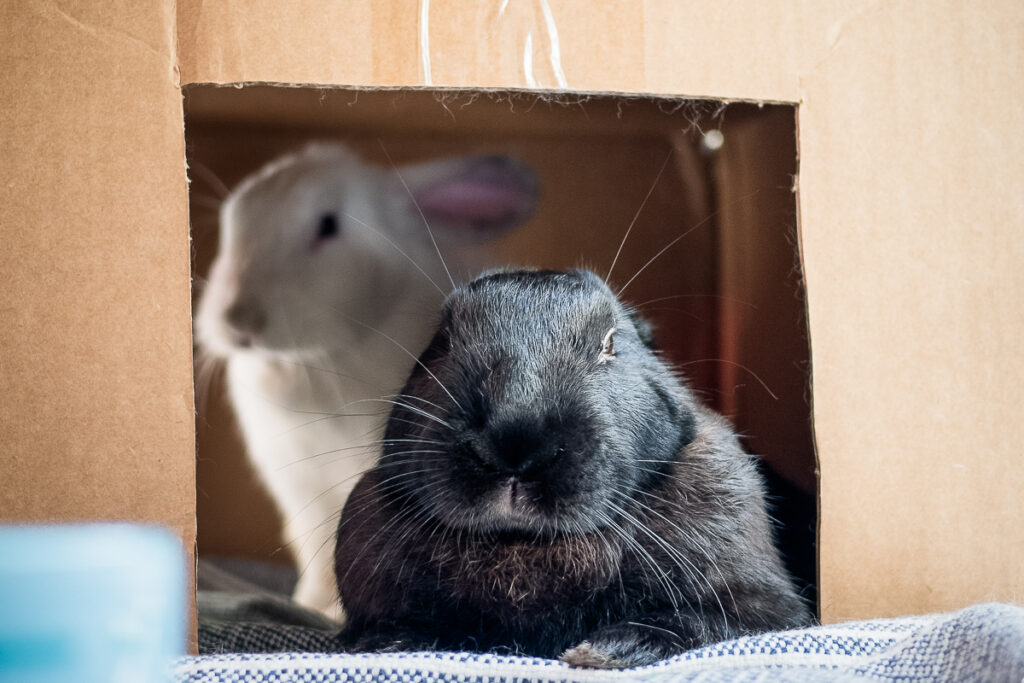Fortunately, we will never fully understand the depths of the rabbit psyche. The mysteries will remain. However, there are a few basic rules about interacting with rabbits that can be very useful in preventing or solving misunderstandings. These can literally be life-saving for the rabbit, as many people’s last resort in “solving” a behavior problem is to get rid of the animal. Think of these tools as access roads into the wilderness of your rabbit’s true inner self. They will take you to the entrance point of that unique territory-and probably save a few of your carpets and phone cords along the way.
Question: My rabbit, Harry, leaves puddles and piles everywhere! He’s three months old. We were told he’d be housebroken by now. We want him to be a house rabbit, but we have to keep him in his cage more and more, which seems really cruel.
Tool of the trade: One of the single most important concepts to become familiar with is setting up for success. Like us, rabbits (and dogs and cats and dolphins and rats) learn best by getting it right and being rewarded, not by doing the wrong thing and being punished. Success in this case is defined as using that rectangular plastic box as the one and only toilet area. You can set Harry up to succeed by giving him lots of success areas, i.e., litterboxes. Look around your home. There are an almost infinite number of wrong places for Harry to eliminate. So if you give him five litterboxes-one in each corner of the room and one in his cage, for example-you’ll be exponentially increasing his chances of succeeding. As long as his cage has a litterbox, as well as toys and anything else he likes, then confinement is not cruel but kind. A cage is only a prison if he’s miserable in there and not learning anything that will lead to freedom later.
Question: Flora has gotten so moody lately. I never know whether she’s going to cower under the chair or rush out and nip my ankle. She’s shredding the carpet, too, and carrying pieces of it around in her mouth. I know she’s not pregnant because she’s never been with another rabbit, but she sure acts like she is sometimes. I even saw her pulling fur out of her belly yesterday.
Tool of the trade: Poor Flora! Her hormones are telling her one thing, and her entire lifestyle is set up for something else. The concept here is to meet her halfway. Having brought these animals into our human world, we must now try to make life with us as easy for them as we can. Fortunately the solution here is one of those rarities in life, an unmixed blessing. Get her spayed immediately, and you will prolong her life, prevent her from contributing to the tragic rabbit overpopulation problem, make it possible for her to have a rabbit companion, and put an end to the mood swings and false pregnancies she’s suffering now.
Question: Please help me before my house crumbles to the ground or explodes in flames! Every time I turn around, Lily is chewing on something she shouldn’t. First it was the baseboards, so I sprayed them with one of those repellents. Then it was the carpet, so I kept her out of the carpeted areas. Now it’s the phone cords. Where will it end?
Tool of the trade: Each of Lily’s actions has met with a “no” but no “yes.” Yes is a critical concept in problem-solving and training. The tool here is to redirect rather than squash. It’s much easier to teach Lily to “chew this, this, this, and this” than to try to convince her not to chew at all. She’s trying to tell you that she really likes to chew. Give her chew toys made of straw, untreated wood or wicker, or cardboard; heavy plastic baby-toys or cat-toys; a towel or rag. By all means keep her away from the “no” items, but give her three yeses for each no.
Question: Iris is just plain mean. She growls, she lunges, she nips, she bites, and usually for no reason at all. One time I might be petting her and everything’s fine, and then all of a sudden she’ll give me a hard nip that really hurts. I guess it’s just in her genes or something.
Tool of the trade: Let’s look at some definitions now. All of these situations that we call behavior problems are actually perfectly normal, natural, and necessary actions on the part of the rabbit. The problem arises with our human demands and expectations. We want Harry and Flora and Iris and Lily to eliminate in a particular place, to chew certain objects and not others, and to refrain from communicating with us via biting-and that’s just a partial list. It’s important to realize that there’s nothing “wrong” with a rabbit who bites, just as there’s nothing unnatural about not wanting to be bitten. Why does Iris bite? She bites as a way of saying “Leave me alone”; “Don’t touch my food bowl today”; “I don’t trust you”; “You smell weird”; and a dozen other possibilities. A more detailed case history would help us to know what’s causing these bites and how to deal with them.
Question: Molly is so shy, sometimes my friends wonder if I have a rabbit at all. The slightest little thing will terrify her, and it seems like all she wants to do is hide under the bed.
Tool of the trade: One of the most useful skills to acquire in living with Molly is to see things from the rabbit’s point of view. It’s a very different world down there, to your small, sensitive, prey animal. What are those long ears and whiskers, big eyes and twitching nose for, if not to take in and react to stimuli? Shyness can be of great survival value in many situations. Molly may be able to learn that as a safe, protected house rabbit she doesn’t need to be quite that alert to possible danger, but as with the biting bunny, there’s nothing abnormal about shyness-in fact, confidence is much rarer in rabbits.
Each of the questions above has been dealt with in detail in previous issues of the House Rabbit Journal. If you need help with a specific problem, check your back issues. I hope that you’ve gotten a sense of the underlying principles that unite the various solutions, so that you can work with your rabbit to solve any communication gaps.
©Copyright Amy Espie. All Rights Reserved. Republished with the permission of the author.
Tools of the Trade was originally published in House Rabbit Journal Volume II, Number 12

